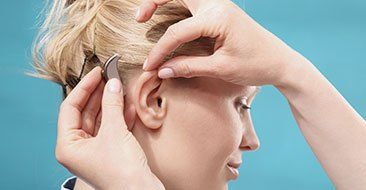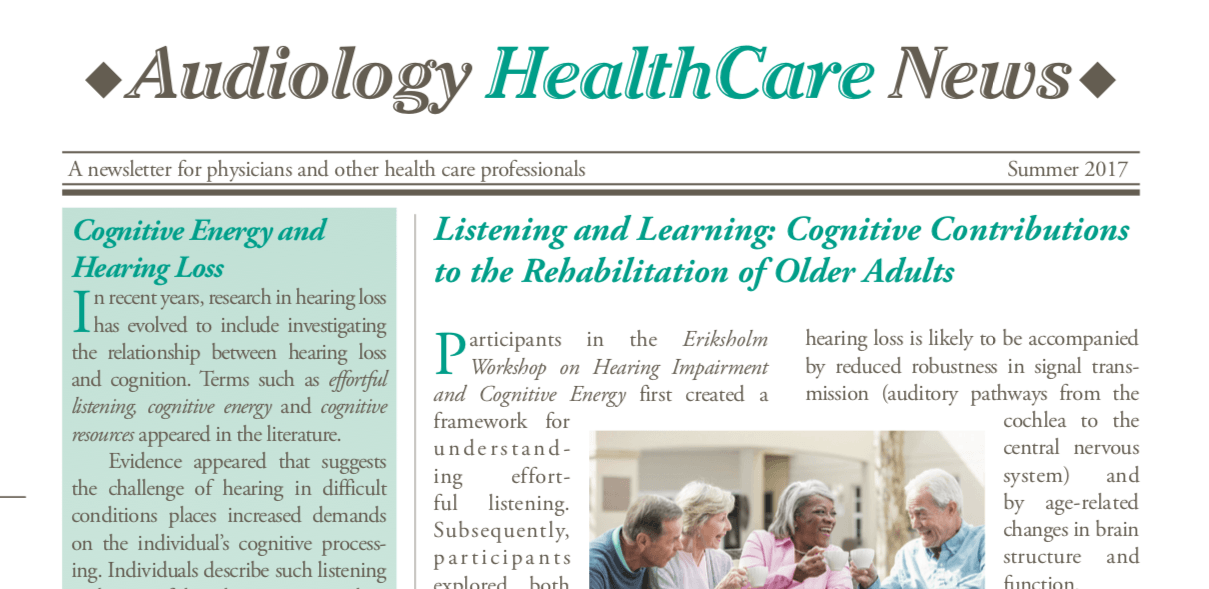Marketing
Enhance Consumer Satisfaction By Marketing To Your Present Patients
Dennis Hampton, Ph.D., CCC-A, FAAA

Long-term patient loyalty is the key to the success of any practice. Whether we call it patient loyalty, consumer satisfaction, or repeat business, any practice that fails to build on the support of its current patients is faced with a constant struggle to find new patients from the general population.
Unfortunately, our consumers-the people with hearing loss who use our services-are not very satisfied with the services they're getting. According to MarkeTrak III research on 2323 hearing aid users, about 20% of hearing aid users are "dissatisfied" or "very dissatisfied" with their hearing aids.1 About 22% are "neutral" and only 58% are "satisfied" or "very satisfied.
"What are the dispenser services that hearing aid users are most and least satisfied with? The four factors rated highest were friendliness, office appearance, patience, and the dispenser's explanation of how to use hearing aids. Of the 12 items listed, the dispenser service ranked lowest in consumer satisfaction was post-purchase service.
This should be very disturbing news. We know that most people who should be using hearing aids aren't. Market penetration is extremely low; according to some estimates, only one in four people who should wear hearing aids actually do so. MarkeTrak III data indicate that nearly two-thirds of hearing aid users who are "dissatisfied" or "very dissatisfied" would not recommend hearing aids to their friends. And, although there may be many reasons for dissatisfaction, one of the chief reasons given by hearing aid users is lack of follow-up service.

FOLLOW-UP SERVICE IS KEY
Therein lies our opportunity. As pointed out by Gitles, it's time to stop blaming the manufacturers and start looking at our own practices. How many of us routinely survey our patients to determine how we're doing? How many of us provide specific follow-up services beyond the initial hearing aid fitting? How many of us have specific techniques that are designed to increase consumer satisfaction and patient loyalty? These services are important to our patients, critical to the success of our own practices, and crucial to the long-term growth of this field.
Why are these services so important? First, because hearing loss is a chronic problem and patients benefit from the long-term relationship they establish with their audiologist. Over the course of that relationship, the person with a hearing loss can learn and understand more about his or her hearing loss. This leads to greater acceptance and greater satisfaction.
Second, because service-not product quality-is the most important factor in determining patient satisfaction. In fact, the most common reason people give for leaving a practice is lack of service: They didn't feel cared for. Practices that want to retain their current patients and improve their level of patient satisfaction can develop patient loyalty by providing excellent follow-up services.
And third, when it comes time to purchase additional services or products, the most important factor in choosing where to go for those services or products is familiarity with the service provider. Thus, if we wish to sell additional products and services to our current patients, we have to develop a relationship of familiarity.
In other words, post-fitting service is the source of considerable consumer dissatisfaction, when these services should instead be the foundation of increased patient satisfaction, long-term patient loyalty, and long-term growth.
SPECIFIC TECHNIQUES
There are several post-fitting services that can provide increased patient satisfaction. These include: a follow-up letter, a patient-satisfaction survey, a battery club, a patient newsletter, a periodic hearing aid service reminder, and an annual hearing and hearing aid check-up. Some of these services provide additional information, while others are additional office services. Several are also sources of significant additional practice income.5
The techniques described below assume that the dispenser has ready access to a good data-management system. A good computer, with sufficient speed and memory and an effective software package, is a prerequisite for frequent patient contact and follow-up. Using an effective office computer system, you can incorporate the techniques described below into your office routine. Doing so requires little effort and cost on your part and produces an extremely high rate of return on your investment.
POST-FITTING LETTER
A great deal of patient education and counseling takes place during the hearing aid fitting process. In addition to providing information about hearing loss and hearing health care, you are telling the patient about the warranty, hearing aid care, batteries, and other services that you offer. Although you cover these areas during office visits, sending a follow-up letter a month after the final hearing aid visit reinforces that information. At the same time, the follow-up letter is an opportunity for you to thank the person for choosing your office and lets patients know that you are still interested in their welfare.
PATIENT SATISFACTION SURVEY
A written survey is the only way to find out what your patients like-and don't like-about your services. People tend not to tell their practitioner when they're unhappy, but they will tell other people, and they will tell you if they are asked. Usually they are not asked.
You should conduct the patient-satisfaction survey 4 to 6 weeks after the final hearing aid visit. Numerous written survey tools are already available, ranging in length from one page to seven or more pages. The return rate is usually extremely high because your patients want you to know what they think of your services.
A good survey should cover the patient's whole range of experiences at your office, including the warmth and comfort of your office, the courtesy of your staff, ease of communication over the telephone, satisfaction with your professional services, and your patients' level of satisfaction with their hearing in a variety of settings.
The results can be used to identify what your practice is doing well and what needs to be improved. The survey also enables you to contact unhappy patients for additional follow-up. But without the specific feedback of a consumer-satisfaction tool, you are operating purely from assumption.

BATTERY CLUB
Battery sales can be both a patient service (offering availability and convenience) and an important source of revenue. There has been increase attention recently on the importance of battery sales.6 Dispensers estimate that 50% of their patients purchase batteries from them.7 However, we have found that when dispensers are asked to track actual battery purchasing patterns, they find that only about 30% of their hearing aid users purchase batteries from them.
Thus, the typical office has the potential to double battery sales if it embarks on a specific program to do so. Increase battery sales mean significantly increased office revenues, of course. Increasing battery sales also increases your opportunities for contact with the hearing aid user. We have found through our subscribers that the way to increase battery sales is through a battery club that offers convenience, savings, and communication.
- Convenience: People will pay for convenience. Convenience means that batteries are mailed on request, without charge for postage, and the office keeps track of battery size and typical usage. Using coupons or cards will act as a barrier and lower participation in the battery club.
- Savings: The most successful battery clubs ask patients to pay for batteries in advance, and they give a 10% or 20% discount for the prepayment (such as 10 packages for the price of eight). People love the savings and the convenience of not having to pay each time they order batteries.
- Communication: You should remind patients about the battery club every time they get new hearing aids, every time they purchase batteries, and regularly through a patient newsletter or other mailing.
HEARING AID SERVICE REMINDER
Many practices recommend that their hearing aid users return every 6 months or so for a brief hearing aid cleaning. This can include cleaning the volume wheel, retubing, and inspecting the microphone and receiver openings.
The office data base program can easily recall users, or the patient newsletter can serve as the general reminder for the hearing aid service. This program helps minimize problems and cut down on repairs, and it demonstrates to your patients that you are interested in providing as much service as possible.
ANNUAL CHECK-UP
Probably the most important (though underused) technique for improving consumer satisfaction is the periodic hearing and hearing aid check-up. While most practices have an annual recall program, in our experience the typical practice sees only about 25% of its patients every year. In fact, many dispensers do not even know what percentage of their hearing aid users come in for periodic check-ups. By implementing a carefully designed recall program, you can count on seeing 70% or more of your hearing aid users every year. Thus, a hearing monitoring program can also be an important source of income.
The fundamental purpose of the recall program is to improve patient satisfaction. You accomplish this by using the visit to:
1) improve patient understanding of hearing loss;
2) discuss communication abilities and strategies;
3) monitor hearing levels;
4) check, clean, and readjust hearing aids; and
5) review other sources of help. As mentioned earlier, regular communication is the key to patient loyalty.
Why does the typical practice see only 25% of its hearing aid users every year? In most of the practices surveyed, the annual visit has not been viewed as an integral part of the rehabilitation program, and the importance of the visit has not been communicated to patients. For example, sending patients a card that says "It's time for your annual check-up. Please call the office," is simply not an effective way of motivating patients to schedule a visit.
To succeed at the 70% or better level, you must communicate to your patients the importance and the benefits of the annual visit, and you must reinforce that message repeatedly. You should explain the importance of the annual visit at the final session of the hearing aid fitting. You can repeat this in your post-fitting letter (see above), and you can also describe the benefits from time to time in the patient newsletter. Finally, on the first anniversary of the fitting, you should send the patient a personally addressed letter (not a postcard) reminding him or her to call to schedule the annual visit. You can also follow up the letter with a phone call.
Your recall letter should itemize the features of the visit in terms of benefits to the patient. For example, you might explain that during the visit you will test the patient's hearing to identify any change and, if necessary, refer the patient for medical care or adjust his hearing aids. You can also tell patients that you will: examine their ear canals (to identify any ear wax problems); clean their hearing aids (to maximize hearing aid performance and minimize repairs); perform real-ear measurements (to maximize hearing benefit); and discuss assistive listening devices and other ways of maximizing their communication abilities.
An effective recall program motivates patients by stressing the importance of the visit, it reminds them when the visit is due, and it then provides a service that is valued by the patient. Once you've made the initial commitment, it takes very little time and effort to establish and maintain an effective recall program. The costs-primarily postage-are minimal if you have an effective computer system in place. The return, both in patient satisfaction and office income, is substantial.

PATIENT NEWSLETTER
There is a great deal to learn, understand, and accept about hearing loss-more than can be accomplished in 6 or 8 weeks of follow-up visits. A patient newsletter is an extremely effective tool for helping you stay in touch with patients, providing additional information and advice about hearing loss and hearing health care, and letting patients know about other services that are available (such as the battery club already discussed). Regular communication is crucial to establishing client familiarity and loyalty.
For example, a patient newsletter can explain why loud sounds are a problem, the advantages of binaural hearing, recent advances in hearing aid technology, and the benefits of lip-reading. You can also use the newsletter to provide patients with information about the battery club, your office schedule, and new products that you have available.
The key to a successful patient newsletter is substance, not style. That is, the substance or information in a newsletter should be of benefit to the hearing aid user, not the dispenser.
You should mail your newsletter on a periodic basis, probably quarterly. Unfortunately, in many cases dispensers have promised a newsletter to their hearing aid users, sent one or two issues, and then lost the interest or the commitment to produce the newsletter. Never, ever promise to deliver a product that you are unable to deliver as promised.
You can produce a successful newsletter on a home typewriter or word processor. You can make copies on your office photocopy machine using regular 8" by 11" paper. You don't need glossy paper or photographs or desktop or professional publishing.
Since 1986, Hearing HealthCare News has produced customized patient newsletters for hearing care professionals throughout the United States and Canada with more than ten million copies distributed to date. We have learned that: (1) Patients love the extra care and information; (2) newsletters are extremely effective at developing patient loyalty and consumer satisfaction; (3) newsletters are inexpensive, costing from $1 to $3 a year per patient for four issues (plus postage); and (4) a patient newsletter can generate significant income by stimulating sales of products and services.
SUMMARY
The purpose of this article has been to describe an important problem and opportunity in the hearing health care field.
The area of hearing loss and hearing health care is a complex one that even most people with hearing loss do not fully understand. Patients using our services and products are frequently dissatisfied with the results of the care we have been providing, and the area of greatest dissatisfaction is post-purchase service. This dissatisfaction should not be surprising if we honestly assess the follow-up services that we have been providing-or failing to provide.
This article has briefly described some ways to improve post-fitting services and thereby raise the level of consumer satisfaction. The implications of improved consumer satisfaction are crucial for both the individual practitioner and for the field of hearing health care as a whole. The potential for growth is tremendous, and that opportunity beckons us.
REFERENCES
1. Kochkin S: MarkeTrak III identifies key factors in determining consumer satisfaction. Hear J 1992; 45 (8): 39-44.
2. Gitles T: Communicative interaction-it involves a lot of hand holding. Hear Rev 1994; 1(1): 8-10.
3. Levinson J: (1984). Guerilla Marketing. Boston: Houghton Mifflin; 1984.
4. Bernstein A, Freiermuth D: The Practice Builder. Englewood Cliffs, NJ: Prentice Hall; 1992.
5. Hampton D: Internal marketing for the established audiology practice. AJA 1992; 1 (3): 57-60.
6. Strom K: Give your hearing care business a battery boost. Hear Rev 1995; 2 (2):12-15
7. Skafte M: Review of 1994 instrument market: A dispenser survey. Hear Rev 1995; 2 (3): 16-60.
8. Hampton D: (1989). The patient newsletter: A win-win solution. Feedback 1989; Summer:29-30.
This article originally printed in Vol.48, No. 9, September 1995 , of The Hearing Journal